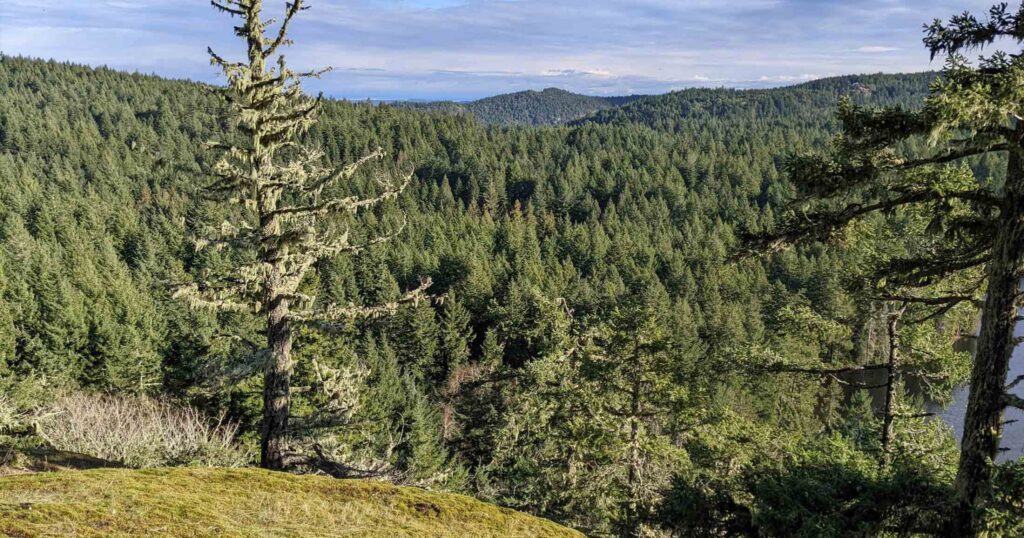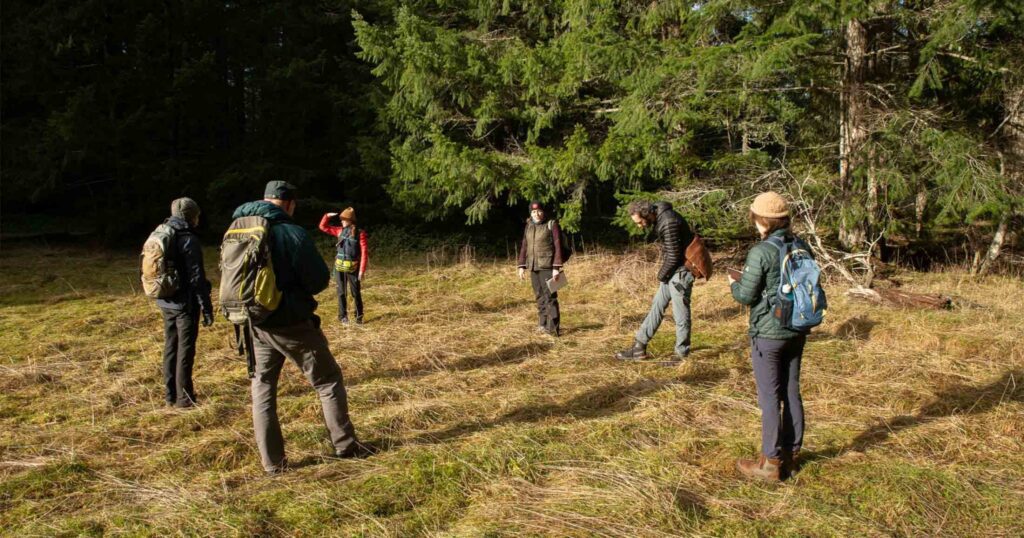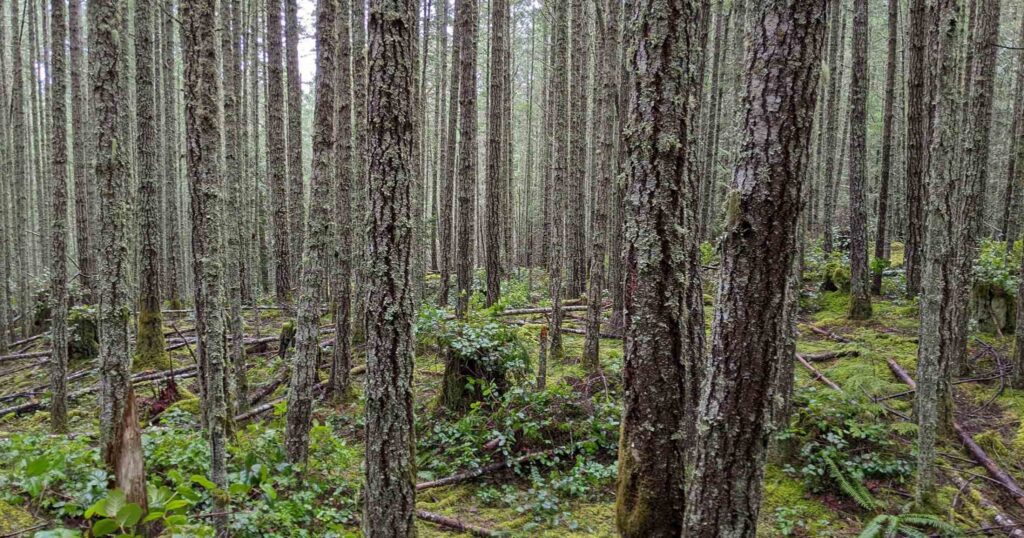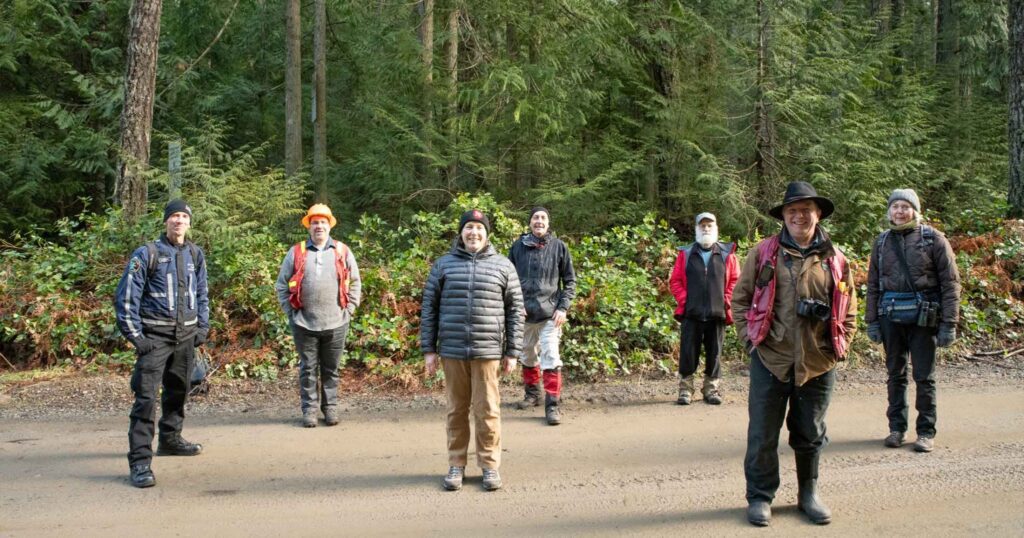By Shauna Doll, Gulf Islands Forest Project Coordinator
A watershed-level restoration initiative focusing on improving ecological integrity within local forests
Transition Salt Spring has partnered with experts and organizations from across the Coastal Douglas-fir biogeoclimatic zone, including Raincoast Conservation Foundation, to provide a model for on-the-ground, multidisciplinary, multisectoral, and collaborative climate action.
Gulf Islands Forest Project Coordinator Shauna Doll interviewed Ruth Waldick from Transition Salt Spring to learn more about the project.
What is the Maxwell Creek Watershed Project?
The Maxwell Creek Watershed Project is a watershed-level restoration initiative. As the project name indicates, its focus is the Maxwell Creek Watershed on Salt Spring Island (SSI), BC. The project aims to improve ecological integrity within local forests while simultaneously strengthening understanding of, and addressing:
1) the risk and spread of catastrophic wildfire,
2) water quality and supply, and
3) other vulnerabilities due to extreme weather and other climate change impacts.
This project seeks to fill existing knowledge gaps by compiling a baseline dataset, recording the current conditions of a representative watershed for the Gulf Islands and other areas within the Coastal Douglas-fir (CDF) biogeoclimatic zone. Though its impetus was motivated by an interest in reducing climate change vulnerabilities locally, its execution has region-wide implications as the state of SSI’s natural systems is much like other islands and coastal communities around the Salish Sea. As such, one outcome of this project is that it will serve as a demonstration site, providing an easily replicable project framework and methodology. Another outcome is the creation of a regional community of practice, so resources and learnings can be shared along with project data through an online data portal. The project team hopes this will reduce duplication of effort among different islands, and increase collaboration between historically siloed communities.


What was the rationale behind the Maxwell Creek Watershed Project?
Within BC’s current political matrix, climate change response has been limited. At a local level, there is no one organization clearly responsible for responding to increasing risk from fire, reduced water quality and availability, and other threats to ecological integrity. Governments were designed for periods of stability, not instability. Despite declaring climate emergencies, local governance agencies have yet to develop tools to address the complexity and intersectionality of climate change. The only way forward is collaboration among a diverse collection of experts and local knowledge holders. The Maxwell Creek Watershed Project is designed to do just this: demonstrate how experts including ecologists, foresters, conservationists, and those with legislated responsibilities, can work together to address wicked climate problems in real time.
Wicked problem: Unlike mathematical or natural science problems that have clear solutions, wicked problems are societal problems. They are often considered undefinable and unsolvable as they generally depend on political judgment to reach some kind of resolution (noting that a resolution is not the same as a solution). At best, wicked problems are resolved over and over again and generally require input from a diverse array of expertise.
(Adapted from Rittel & Webber, 1973, p. 160)
Further, the Maxwell Creek Watershed is critically important to all communities living on SSI. It supports the water supply for nearly half the island’s population, and supports a diversity of native plant and wildlife species. This watershed-level study is a rare opportunity to 1) improve understanding of shifting ecological baselines and 2) study links between ecosystem conditions and preventative action to reduce risks of the most severe impacts of climate change.
What were the first steps to creating the project?
The first step was building community momentum. This was spearheaded by Transition Salt Spring (TSS) in the community-based development of The Salt Spring Climate Action Plan 2.0. The plan outlines 250 recommendations for individual community members to address the climate crisis locally, including reducing greenhouse gas emissions by 50% by 2030. Another part of this work was the completion of risk assessments to support the identification of highly vulnerable areas. This brought different agencies and groups together to identify the highest priorities of, and greatest obstacles to, meaningful climate action.
This process made it clear that addressing fire risk and water supply concerns were an absolute top priority. Whatsmore, good relationships were built on a growing awareness of the scale of the challenge and an understanding that collaboration between authorities is needed to address common problems. With a group of strong supporters behind us, a joint funding application to implement a community-based, collaborative climate action project was successfully submitted.


How is the project being funded?
Core base funding has come from Environment and Climate Change Canada’s EcoAction fund. While the amount granted is not enough to do ongoing restoration work, it is enough to get the project started. The activities currently supported include site identification, methods design, and pilot restoration action (e.g. tree thinning in dense stands) in small areas. The outcomes of these pilots will eventually be leveraged to apply for additional support to expand the project, allowing for larger-scale and longer-term restoration action.
An important point to reiterate here is that a major driver in the design and implementation of this project is the need for an easily replicable project model. The initiation of this trial or beta version of the project, will ultimately remove the need for other organizations to design projects from scratch. In other words, we aim to increase the capacity of other organizations by doing the preliminary groundwork for them. Accordingly, a data and resource portal for nature-based climate action is being developed. This will be a digital space to share lessons learned, successes, challenges, and technical documents (i.e. validation techniques, methodologies, etc.). We are not just initiating a stand-alone project, but rather creating a community of practice inclusive of practitioners working throughout the CDF zone.
This community of practice has proven to not only include scientific experts. In addition to grant funding, the Maxwell Creek Watershed has increasingly attracted local interest. For example, a private donor recently made a $25,000 contribution and the SSI Local Trust Committee has committed to providing in-kind support by making a fire ecologist available to assist the project team. Finally, there is a growing volunteer base eager to assist with fieldwork and other project needs. This has demonstrated the necessity of prioritizing open project communication and transparency.
What should project funders know?
All projects need people to do the work, but funders do not always recognize this. People should be paid for their time and expertise. The employment opportunities TSS and our partners are creating are the new kind of jobs we need. Though $100,000 grants might seem like a lot, this sort of incremental funding does not make maintaining long-term, meaningful employment feasible. As a consequence, the projects funded this way typically cannot maintain long-term outcomes. On the ground action is key to addressing the climate and biodiversity crises. Yet, local management strategies are either inadequate or altogether nonexistent; they need to be created and this will take time. As such, funders need to identify those leading the way and commit to providing long-term support. So much time is spent applying for grants that could be used doing the on-the-ground work.
It is also important that the onus is not just put on foundation and government funders. There are ample opportunities for individual philanthropists to contribute. There is a high concentration of wealth on BC’s Gulf Islands, and though everyone who lives in this region will benefit from this kind of work, few are willing to invest in it. As an example, 12 years ago the fire hall on SSI was deemed to be unsound. Where it is built was once ocean bottom, so it is highly susceptible to damage from sea level rise and further, it was not built to seismic specifications. Despite many community members being anxious about increasing fire risk due to prolonged and intensifying drought, there has been strong resistance to increasing community investment to move and improve the firehall. But limited access to reliable emergency services translates to a severe lack of community resilience, especially as unpredictable weather events and increasing temperatures amplify due to climate change. This is indicative that as a society, we are stuck in an old paradigm, we are not seeing the climate emergency as the healthcare emergency it is.


What have been the greatest challenges to implementing the project?
This kind of work requires professional input and certain types of restoration ー such as wetland restorationー must go through extensive approval processes. For such projects to proceed, permission at both the provincial and federal levels is often required. As this project is in many ways still in its infancy, we do not have the funds available to properly compensate for the level of professional expertise needed to develop and execute a sound project. As a result, the Maxwell Lake Watershed Project currently depends heavily on volunteer time. Luckily, enthusiasm is not a challenge, there is a lot of interest from both the scientific and local communities in this sort of work.
Another hurdle is limited data availability. Though the local governing authorities have the data layers required to pursue this work, access has largely been barred. Officially this data is meant to be publicly available, logistically it is not and the reason for this is unclear. As a result, we have had to pay for access or send project team members on deep searches to try to find the data we need.
What essential advice would you share to others looking to implement similar projects?
- Support by responsible authorities is important for establishing project credibility and to open the doors to access funding, but this support typically does not extend to the actual execution of the project. That is, project managers should not expect that they will be provided with capacity or resources from supporting government/institutional agencies. A strong network of experts with a diverse collection of skills and experience who also know how to find data and pull it together is thus required.
- Be inclusive and create opportunities for the community to get involved. There is a lot of good expertise out there.
- Be prepared for technical difficulties. When a project is just starting out there is a lot of troubleshooting that needs to be done before things can really get started. It is important to budget for this both financially and temporally.
How has the project management team worked to engage the Quw’utsun people?
Developing relationships is a long process and we are still in the early stages. The project’s management team has been working to find pathways for learning and communicating with members of the Cowichan Environment Committee as we hope that we can reciprocally share learnings with the communities who have such long links to this place. One small step forward is for us to start using the Hul’qumi’num language. We aim to familiarize ourselves with the histories and original place names from a time before the watershed was so profoundly modified by clear-cutting and draining to prepare the land for western agriculture.
Another requirement is the provision of capacity by colonial governments. If the Islands Trust, for example, wants to engage local Nations around land-use planning and management priorities, then they really need to provide the resources to allow that to happen, rather than expecting members of the Nations to add it to their desks as additional pieces of work when there are already such high demands on their time. Government-to-government engagement is needed and community councils need to be staffed. We do not want to add to anyone’s workload because we understand that everyone is capacity challenged. That said, we want to continue relationship building and hope to collaborate with the Nations who have called this watershed home since time immemorial in any way that our collective capacities allow.
Who are the members of the Maxwell Creek Watershed Team and what are their roles?
Brinkman and Associates: Sharing technical expertise and guidance.
Environment and Climate Change Canada: Provision of start-up project funding
IMMERS (Institute for Multidisciplinary Ecological Research in the Salish Sea): Contributing to the development of project methodologies and science outreach.
North Salt Spring Waterworks District: Providing access to the Maxwell Creek Watershed and enthusiastic support for this project.
Raincoast Conservation Foundation: Developing communications and providing field support
Salt Spring Island Conservancy: Providing land access for fieldwork and field support.
Salt Spring Fire Rescue: Sharing expertise and actively participating as members of the project’s learning community, with the intention of mobilizing the science produced by the project into land management practice.
Salt Spring Local Trust Committee: Providing in-kind support for contributions from a local fire ecologist and hosting an expert workshop.
Salt Spring Island Water Preservation Society: Providing land access for fieldwork and contributing field and outreach support.
University of Victoria Restoration Program: Developing curriculum and learning resources, and providing access to data and future field support
Special mention should also be made to the Conservation Decisions Lab at the University of British Columbia and the Capital Regional District for their input to date.


When can people expect to see results from the project?
Technical teams are already compiling resources for other practitioners to use. Raincoast Conservation Foundation is working with us to help disseminate project information to the wider community. This interview is just the first in a series that will document project progress, methodologies, and outputs. These will be regularly posted to both Raincoast and Transition Salt Spring’s websites.
About Ruth Waldick
Ruth has a master’s degree in Ecology and a Ph.D. in Evolution and Population Genetics; in other words, studying change over space and time. Some of her first research was directed at how land-use affected wetlands and amphibians. She continues to be driven by similar questions about change, including how we can anticipate and build resilience to climate change in our communities and the natural systems that support us. For the last 20 years, she has focused on how best to apply science to support policy and land management. Most recently, she helped incorporate climate adaptation considerations into the Salt Spring Island Climate Action Plan (2.0).
This project was undertaken with the financial support of the Government of Canada through the federal Department of Environment and Climate Change and a private donor, to promote the use of nature-based solutions to build resilient communities.
References and additional information
Burns, R. (2022, June 15). The climate changers: Protecting Salt Spring’s water supply from fires and droughts. [Radio broadcast]. CBC. https://www.cbc.ca/listen/live-radio/1-93-all-points-west/clip/15919388-the-climate-changers-protecting-salt-springs-water-supply
Rittel, H.W.J. & Webber, M.M. (1973). Dilemmas in a general theory of planning. Policy Sciences 4, 155–169. DOI: 10.1007/BF01405730
